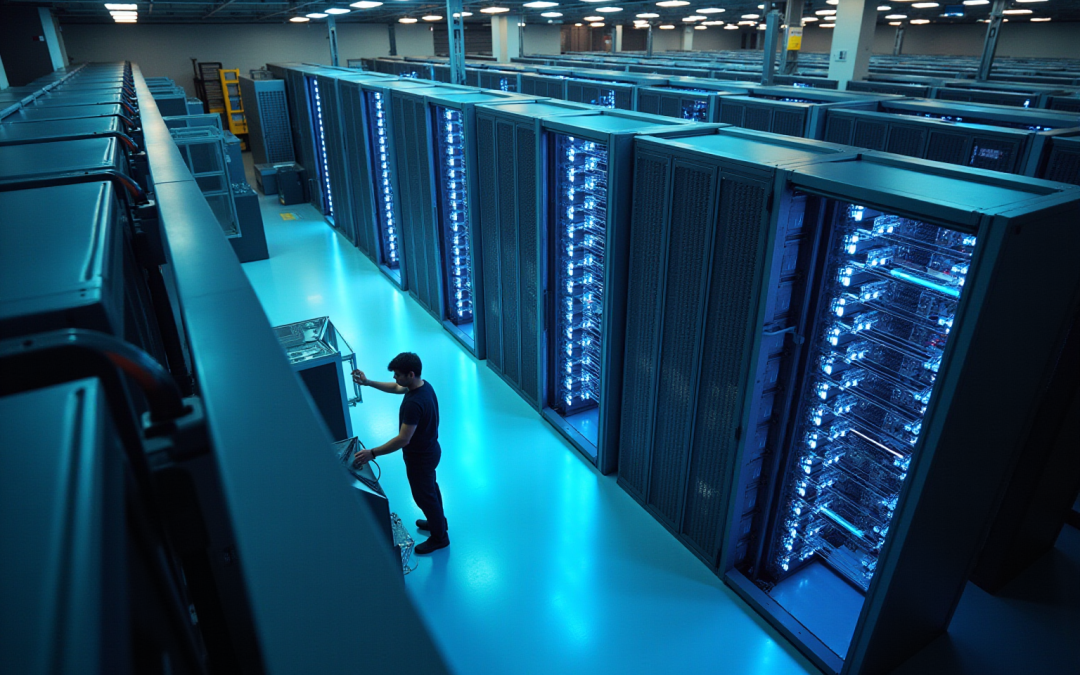Overview
This article delves into innovative cooling solutions for data centers, emphasizing the critical need for efficient temperature regulation to boost both performance and sustainability. It presents a range of advanced techniques, including:
- Liquid cooling
- AI-driven systems
- Immersion cooling
These techniques are proven to significantly lower energy consumption and enhance operational efficiency. The discussion underscores the vital importance of integrating these technologies into contemporary data center designs, advocating for their widespread adoption to meet the evolving demands of the industry.
Introduction
In the rapidly evolving landscape of data centers, the quest for efficient cooling solutions has never been more critical. Energy consumption from cooling systems often accounts for a staggering percentage of total operational costs, prompting organizations to seek innovative technologies that enhance performance and sustainability.
Pioneering liquid cooling systems and cutting-edge AI-driven approaches are transforming the industry, promising not only to reduce energy usage but also to optimize the management of thermal loads.
As engineers and data center operators navigate this complex terrain, understanding the latest advancements in cooling technologies is essential for achieving operational excellence and meeting the growing demands of modern computing environments.
Gagner-Toomey Associates: Pioneering Innovative Cooling Solutions for Data Centers
Gagner-Toomey Associates is at the forefront of for information hubs, focusing on cutting-edge technologies that significantly enhance efficiency and performance. As the world’s largest producer of both standard and custom air-movers, Gagner-Toomey Associates delivers advanced specifically designed for to meet the unique demands of modern facilities. Given that temperature regulation mechanisms in a cooling data center account for over 40% of total energy consumption in these facilities, the importance of cannot be overstated.
Recent studies reveal that the adoption of in a cooling data center—such as distributed air flow control and vertical server placements—can result in considerable energy savings. For instance, simulations from a recent study demonstrated that these novel approaches could markedly reduce in a cooling data center compared to traditional setups.
Furthermore, Gagner-Toomey’s extensive portfolio includes:
- (available in sizes from 15 to 280mm)
- Centrifugal Blowers (ranging from 15 to 225mm)
- Thermal management solutions like extruded aluminum heatsinks and integrated temperature control systems
This ensures optimal performance across diverse applications. Most models also provide IP protection upon request.
With over 15 million professionals engaged in the refrigeration sector, the impact of extends beyond individual facilities, contributing to broader industry sustainability initiatives. As a trusted partner for engineers, Gagner-Toomey Associates leverages its expertise in temperature regulation, , and interconnect technologies to optimize operations in a cooling data center, enabling clients to achieve both sustainability and performance goals in an increasingly energy-conscious landscape.
The dual role of AI in enhancing energy efficiency while addressing rising demands further emphasizes the relevance of Gagner-Toomey’s solutions in today’s data-driven environment. Engineers are encouraged to evaluate their current temperature regulation practices and consider implementing innovative solutions, such as distributed air flow control, to boost efficiency and reduce energy consumption.
Liquid Cooling: Enhancing Efficiency and Performance in Data Centers
are increasingly recognized for their exceptional ability to enhance facility efficiency and performance. By employing liquids as a temperature-regulating medium, these systems effectively dissipate heat, enabling higher density server configurations that traditional air methods cannot accommodate. This approach not only leads to significant but also reduces the overall footprint of , making it an ideal solution for modern cooling data centers confronting escalating thermal loads.
Recent advancements, including the , specifically address the rising demands of AI applications, demonstrating how can adapt to the evolving needs of the industry. Moreover, critical components such as and pumps play a vital role in these systems, facilitating effective heat transfer and coolant circulation essential for maintaining optimal operational conditions. provides , featuring solenoid pumps that can operate up to 16 Bar, tailored for precision applications in electronics. These pumps incorporate a DC brushless motor and EMI suppression circuit, ensuring low noise operation and compliance with automotive standards, making them ideal for integration into .
As we approach 2025, the benefits of liquid temperature regulation setups for cooling data centers are becoming increasingly evident, with real-world examples illustrating their effectiveness in enhancing data center productivity. Industry experts stress that these frameworks not only improve performance but also contribute to sustainability goals by minimizing energy consumption. Importantly, liquid refrigeration options occupy less space than conventional methods, making them a practical choice for engineers focused on space optimization.
With over 40 years of experience in developing advanced , Boyd exemplifies the innovation driving this trend, ensuring optimal performance in server facilities and AI applications. As Jeff Howell, President at ENCOR Advisors, articulates, “With 24 years of experience in real estate advisory, supply chain consulting, and high-growth SaaS, I’m focused on driving innovation and impact,” underscoring the importance of innovative solutions like liquid refrigeration in the contemporary information infrastructure.
AI-Driven Cooling Systems: Revolutionizing Data Center Operations
AI-powered are revolutionizing server facility operations by employing advanced algorithms to enhance climate control tactics in real-time. These systems continuously evaluate information from a network of sensors, dynamically adjusting temperature outputs to maintain ideal thermal limits. By accurately forecasting temperature management needs based on workload variations, —potentially decreasing energy usage by up to 10% without necessitating new infrastructure. This capability not only boosts operational efficiency but also establishes as a vital element in the design of modern .
As organizations increasingly shift to colocation cooling data centers, the demand for becomes more critical than ever. With 60% of organizations reporting a repatriation of AI workloads due to high cloud costs, the integration of AI in temperature regulation strategies is emerging as a transformative approach to resource management and cost reduction. Notably, , highlighting the significance of these advancements.
Moreover, discussions led by Demis Hassabis, CEO of DeepMind, with the National Grid regarding in enhancing energy efficiency. For engineers, the consideration of in their designs can substantially improve resource management and operational efficiency.
Immersion Cooling: Reducing Energy Consumption and Enhancing Thermal Management
Immersion refrigeration technology revolutionizes facility operations by submerging IT equipment in a thermally conductive liquid, enabling efficient heat transfer and significantly reducing . This innovative approach not only enhances thermal management but also extends by maintaining optimal operating temperatures. As data centers increasingly adopt higher density configurations, immersion technology becomes a critical solution for in and cost reduction.
Successful implementations have showcased substantial energy savings, with certain systems achieving reductions in energy consumption by as much as 80%. For instance, a groundbreaking initiative in Singapore illustrated the potential of utilizing natural resources, such as seawater, to enhance temperature regulation, aligning with akin to those of Microsoft, which underscores regenerative value for local communities.
Industry leaders, including LiquidStack, advocate for immersion refrigeration as a sustainable practice, with LiquidStack asserting, “We are proud to support Microsoft’s bold sustainability goals and initiatives with its 2-phase liquid immersion refrigeration technology.”
The integration of , such as solenoid and rotary boost pumps from , is pivotal in optimizing these refrigeration systems. These pumps, capable of operating up to 16 Bar and constructed from NSF and WSAS materials, ensure precision in fluid management, thereby enhancing the overall efficiency of .
The benefits of immersion refrigeration extend beyond energy efficiency; they also contribute to water conservation, rendering them an attractive option for eco-friendly facility designs. Engineers considering immersion temperature management solutions should evaluate their existing setups and explore how the integration of this technology, alongside , can elevate efficiency and sustainability in a cooling data center.
For further details on Gagner-Toomey Associates‘ solenoid and rotary boost pumps, please visit our product website.
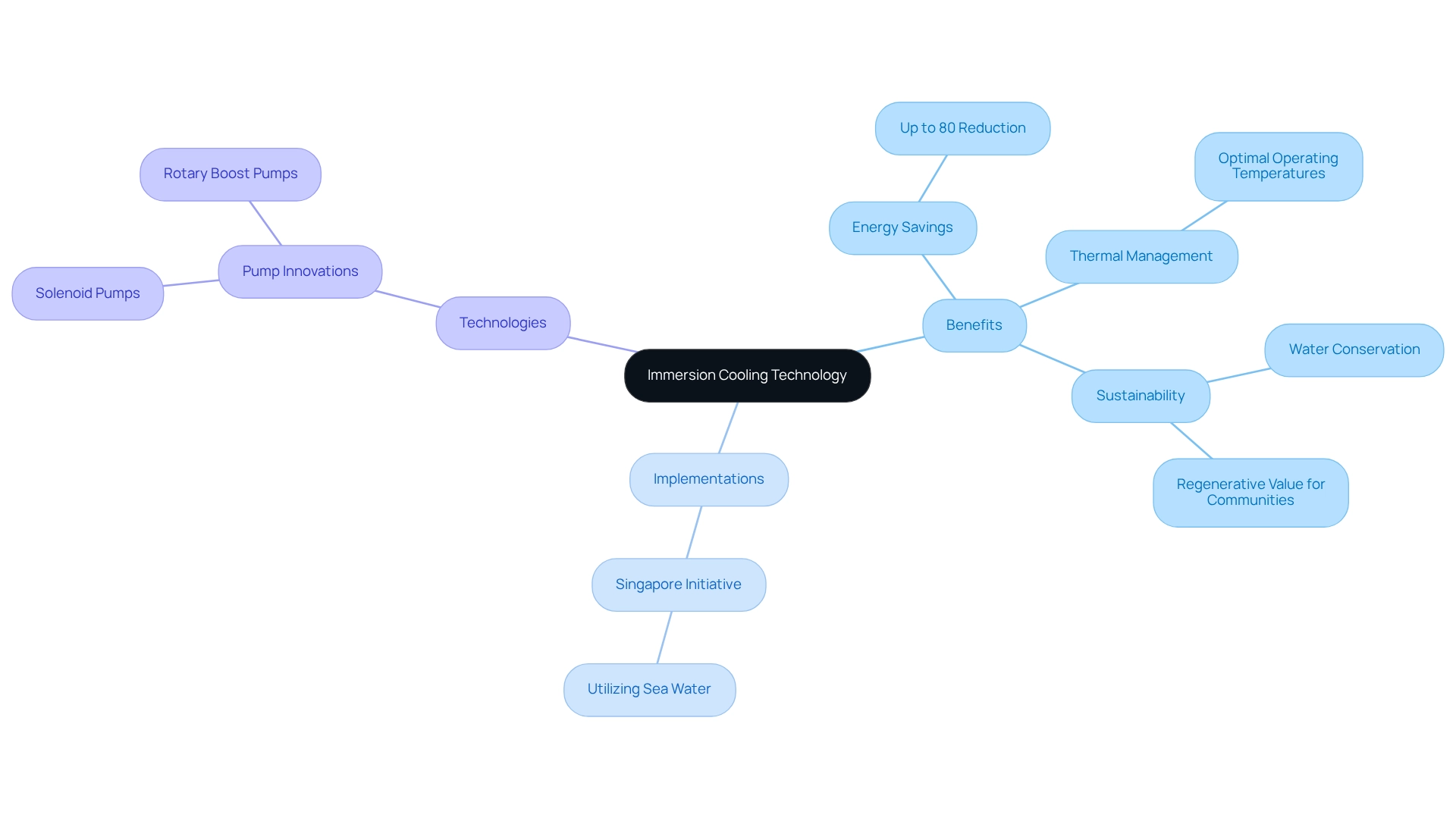
Free Cooling: Leveraging Natural Resources for Sustainable Data Center Operations
Free setups utilize natural environmental factors, such as cool outside air or water sources, to effectively manage temperatures in a cooling data center. By diminishing reliance on energy-intensive mechanical refrigeration, these setups can lead to significant reductions in operational expenses and carbon emissions. In fact, temperature control mechanisms in server facilities typically account for 30-50% of overall energy usage, underscoring the critical importance of . The implementation of free refrigeration not only promotes sustainability but also addresses the escalating demand for within the industry.
A recent study highlighted the challenges faced by data centers in China, where rising energy consumption is primarily associated with temperature regulation systems. The findings advocate for , such as , to address the substantial energy requirements and heat flux density of modern IT equipment. As Hosein Moazamigoodarzi observed, “Experiments reveal that the principal factor influencing the temperature distribution is the leakage of warm air through passive servers, a hitherto unreported facet, which is dependent on the locations of these servers, IT load density and distribution, and cold chamber depth.” This insight reveals the complexities involved in managing temperature distribution, which is vital for .
Moreover, examples of successfully implementing free temperature regulation illustrate its practicality. These facilities demonstrate considerable , showcasing the potential of harnessing . As the sector transitions towards more eco-friendly practices, free refrigeration methods emerge as a crucial solution for enhancing efficiency and reducing environmental impacts. The physics-oriented approach developed in the research can also be applied in information hubs across various climates, reinforcing the adaptability of passive refrigeration techniques.
Hybrid Cooling Systems: Combining Methods for Optimal Efficiency
Hybrid thermal solutions effectively combine various , including liquid and air methods, to enhance efficiency in data centers. By leveraging the strengths of diverse technologies, these frameworks dynamically adapt to changing workloads and environmental conditions, ensuring consistent and dependable performance. Notably, advancements in , such as immersion methods and direct-to-chip systems, have demonstrated significant efficiency improvements, particularly in where systems can manage over 80 kW per cabinet.
, recognized as the world’s largest manufacturer of standard and custom air-movers, plays a pivotal role in this landscape. Their extensive portfolio features optimized DC input tube axial fans ranging from 15mm to 280mm and centrifugal blowers from 15mm to 225mm, essential for enhancing . The integration of hybrid solutions not only boosts temperature control capacity for a cooling data center but also offers , rendering them an attractive option for data center operators. These setups are designed to improve energy efficiency, with research indicating that hybrid refrigeration can reduce energy usage by as much as 30% compared to conventional techniques. Regular maintenance of liquid refrigeration setups, including inspections of fluid levels and pump performance, is vital to prevent leaks and ensure optimal functioning, thereby minimizing downtime. This maintenance is critical not only for reliability but also for sustaining the that hybrid setups provide.
As the industry evolves, expert insights underscore the importance of in achieving sustainable data center operations. Stuart Lawrence, VP of Product Innovation and Sustainability, highlights that the widespread adoption of generative pre-trained transformers (GPTs) is reshaping , emphasizing the necessity for adaptable and efficient systems. By merging various temperature regulation techniques, operators can establish a robust infrastructure that meets the demands of modern computing while enhancing energy efficiency and cost-effectiveness.
Furthermore, advancements in liquid temperature regulation technologies, as illustrated in the case study ‘Future of Data Center Liquid Temperature Regulation Technologies,’ demonstrate how innovations like immersion methods and direct-to-chip systems are gaining traction due to their efficiency and scalability in managing heat in high-density server environments. These advancements are expected to enhance refrigeration efficiency and facilitate increased server densities, optimizing space utilization within information facilities.
To fully leverage the benefits of hybrid temperature regulation setups, facility managers should consider integrating Gagner-Toomey Associates‘ into their infrastructure, ensuring they are well-equipped to meet the demands of contemporary computing.
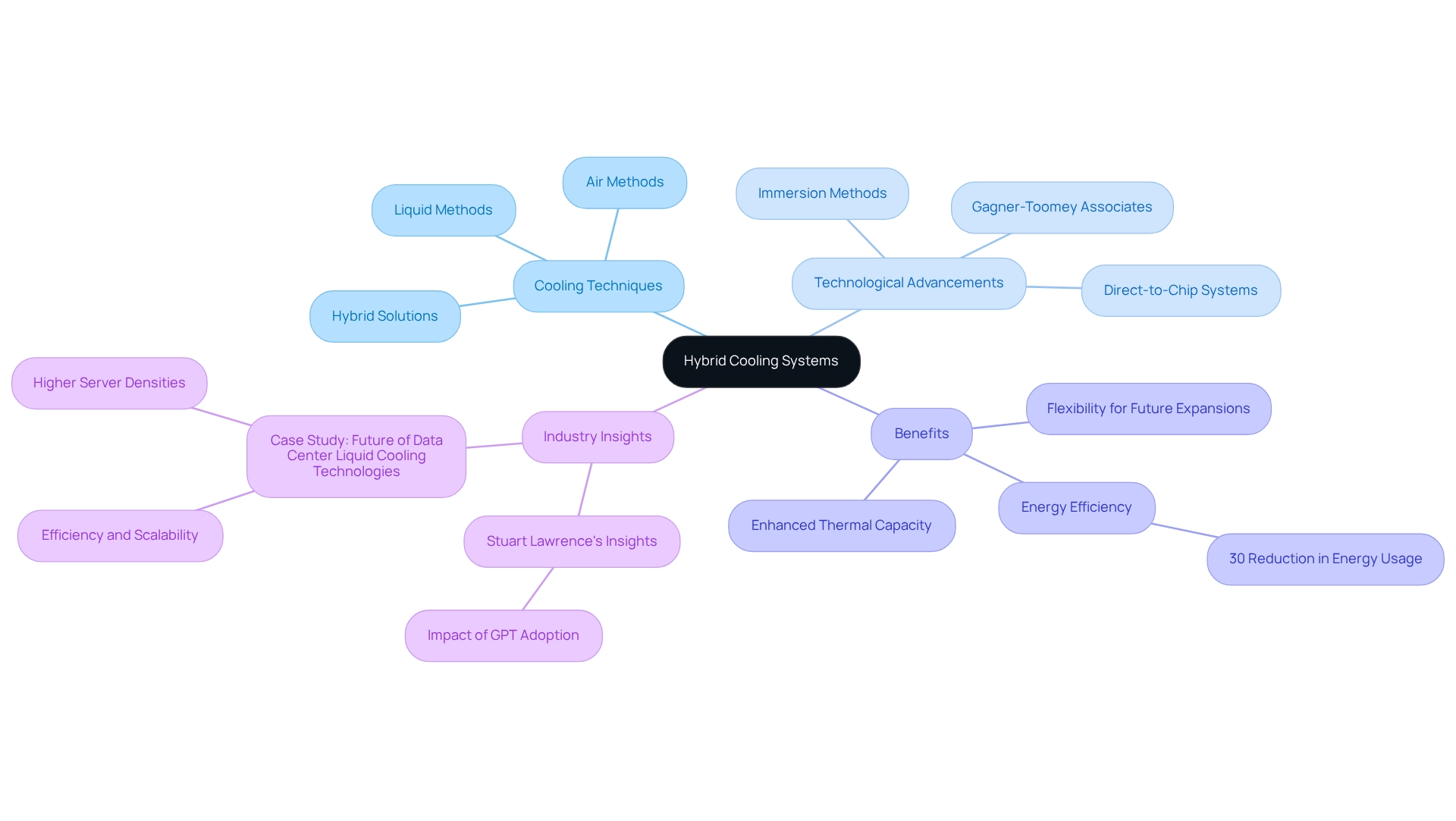
Advanced Airflow Management: Ensuring Optimal Temperatures in Data Centers
are essential for maintaining optimal temperatures in . By strategically designing airflow paths and implementing containment strategies within the , engineers can effectively minimize the mixing of hot and cold air, thereby reducing the strain on temperature control systems.
and optimized vent placements, can lead to significant improvements in the of a cooling data center. For instance, enhancing server setup and airflow in a cooling data center ensures optimal temperature control in facilities, resulting in lower energy costs and increased equipment reliability.
Frequent energy assessments in a cooling data center, as highlighted in the case study ‘,’ demonstrate that identifying inefficiencies allows for , further enhancing and sustainability.
Industry experts, including Evernex, emphasize that a can uncover opportunities for more efficient configurations, ultimately maximizing server performance and throughput.
Moreover, techniques such as adjusting perforated tiles and blanking panels are vital for to implement.
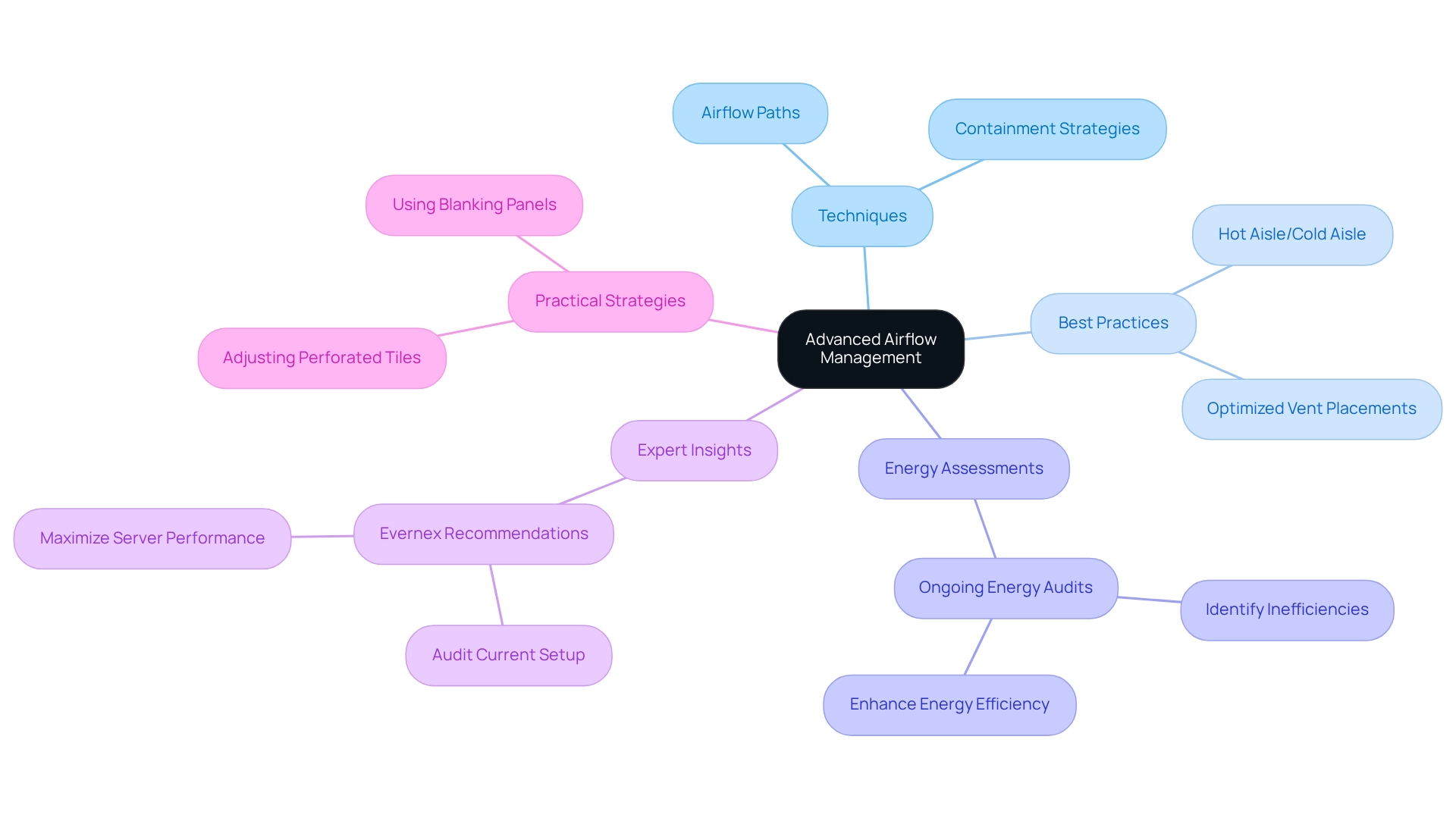
Chilled Water Systems: A Reliable Cooling Method for Modern Data Centers
represent a cornerstone of dependable , effectively utilizing chilled water to absorb heat from the environment. These systems excel at managing substantial thermal loads, making them particularly advantageous for with . By 2025, the efficiency of cooling data centers will be underscored by their capacity to maintain precise temperature control while offering scalability to meet evolving demands. Notably, they are projected to capture a significant market share, reflecting their increasing preference among data center operators.
Currently, Schneider and Vertiv lead the market with approximately 10% market share in 2023, indicating a competitive environment in . Expert perspectives emphasize the reliability of chilled water setups, particularly in cooling data centers, where consistent temperature regulation is crucial in high-density settings. Case studies illustrate successful applications of these setups in a cooling data center, highlighting their efficiency in managing thermal loads and ensuring . As gain traction, chilled water methods emerge as a sustainable solution for a cooling data center, contributing to reduced operational expenses and a lesser environmental impact. Furthermore, row/rack-based temperature control setups are projected to experience the quickest growth rate in the refrigeration segment from 2023 to 2030, mirroring emerging trends in temperature management technologies.
In this competitive landscape, stands out as a prominent supplier of innovative , offering a wide variety of standard and custom air-movers, including DC fans and centrifugal blowers, designed for electronics and automotive applications. The Asia Pacific region currently leads the global market for information facility refrigeration solutions, suggesting a robust demand for chilled water setups in that area.
Direct-to-Chip Cooling: Targeting Heat Removal for Enhanced Efficiency
are revolutionizing heat control in server facilities by delivering precise temperature regulation directly to high-heat components such as CPUs and GPUs. This focused strategy not only enhances but also enables facilities to accommodate greater without sacrificing performance. By minimizing the distance between the heat source and the refrigeration medium, these systems can achieve , leading to improved operational efficiency.
Recent advancements in immersive software and state-of-the-art sensors have proven essential in , ensuring reliability in critical information processing environments. For instance, Colovore’s implementation of liquid , which support rack capacities up to 50 kilowatts, exemplifies the industry’s shift towards that address the escalating demands of modern computing.
The impact of direct-to-chip refrigeration on server farm performance is profound, as it not only boosts but also creates additional space for more servers or essential components, ultimately driving innovation in facility design. As one specialist noted, ‘It also creates room in the server facility that can be utilized for additional servers or some essential components.
Future Cooling Technologies: Innovations Driving Sustainability in Data Centers
Upcoming refrigeration technologies are set to revolutionize server facility operations by significantly enhancing sustainability and efficiency. Innovations such as advanced liquid , which employ to ensure peak performance, are becoming increasingly essential. Additionally, AI-powered analytics are refining temperature management processes by analyzing real-time data to dynamically adjust outputs, thus ensuring maximum efficiency. The use of eco-friendly refrigerants is further minimizing environmental impact.
A notable example is Google’s commitment to water management, where the company aims to reduce water usage in its facilities by up to 50% through innovative , all while maintaining energy efficiency. As Ruth Porat articulates, “Technology innovation, transparency and stewardship will be essential as we work towards building a more sustainable future together.”
The implementation of a 4.2-acre crystalline lagoon for temperature regulation exemplifies this shift; it not only acts as but also boosts efficiency by harnessing natural evaporation processes. As data centers continue to evolve, engineers must remain abreast of these advancements and consider advocating for the adoption of in their projects to achieve long-term sustainability objectives.
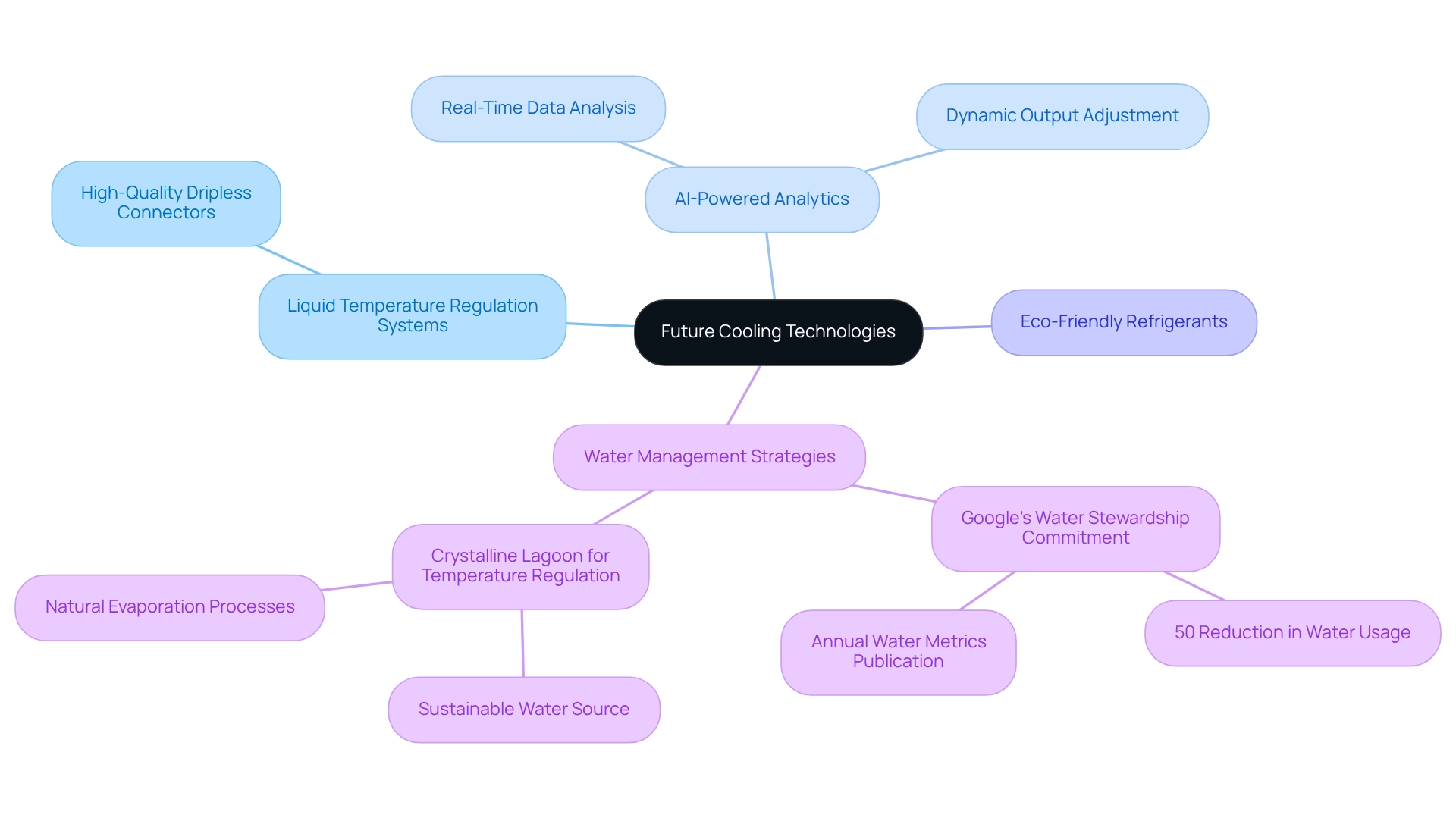
Conclusion
The landscape of data center cooling technologies is undergoing a significant transformation, driven by the urgent need for efficiency and sustainability. From pioneering liquid cooling systems to advanced AI-driven solutions, each innovation offers unique advantages that address the pressing challenges of energy consumption and thermal management. Effective cooling strategies can account for over 40% of total energy usage in data centers, making the selection of the right cooling technology crucial for operational success.
Innovative approaches, such as immersion cooling and hybrid systems, demonstrate remarkable potential for energy savings and enhanced performance. These systems not only support higher density server configurations but also contribute to sustainability goals by reducing the overall carbon footprint. The integration of AI technologies amplifies these benefits, allowing for real-time adjustments that optimize cooling outputs based on workload demands.
Ultimately, adopting advanced cooling solutions is imperative for data center operators looking to enhance efficiency and reduce costs. By leveraging technologies like free cooling, chilled water systems, and direct-to-chip cooling, organizations can create a resilient infrastructure that meets the evolving demands of modern computing. As the industry continues to evolve, engineers and operators must remain vigilant in exploring and implementing these innovative cooling strategies to meet current operational needs and pave the way for a sustainable future.
Frequently Asked Questions
What is Gagner-Toomey Associates known for?
Gagner-Toomey Associates is recognized for pioneering refrigeration solutions for information hubs, focusing on advanced technologies that enhance efficiency and performance in cooling data centers.
Why is temperature regulation important in cooling data centers?
Temperature regulation mechanisms account for over 40% of total energy consumption in cooling data centers, making effective temperature management strategies crucial for operational efficiency and energy savings.
What innovative ventilation concepts can help reduce energy consumption in cooling data centers?
Concepts such as distributed air flow control and vertical server placements have been shown to significantly reduce energy consumption for temperature regulation compared to traditional setups.
What types of products does Gagner-Toomey Associates offer for cooling solutions?
Their portfolio includes DC input Tube Axial fans, Centrifugal Blowers, thermal management solutions like extruded aluminum heatsinks, and integrated temperature control systems.
How do liquid refrigeration solutions enhance cooling efficiency?
Liquid refrigeration systems effectively dissipate heat, allowing for higher density server configurations and leading to significant energy savings while reducing the overall footprint of temperature management infrastructure.
What recent advancements support the use of liquid temperature regulation?
Technologies like Intelliscale™ address the demands of AI applications, showcasing how liquid temperature regulation can adapt to evolving industry needs.
What role do pumps play in liquid refrigeration systems?
Critical components like heat exchangers and pumps facilitate effective heat transfer and coolant circulation, which are essential for maintaining optimal operational conditions.
How does AI contribute to temperature management in data centers?
AI-powered temperature management solutions use advanced algorithms and real-time data from sensors to dynamically adjust temperature outputs, potentially reducing energy usage by up to 10%.
What is the significance of integrating AI in temperature regulation strategies?
As organizations shift AI workloads back to colocation cooling data centers, integrating AI in temperature regulation becomes vital for effective resource management and cost reduction.
What is the projected investment in AI technologies by 2028?
Investment in AI technologies is projected to reach $76 billion by 2028, highlighting the growing importance of AI advancements in various sectors, including temperature regulation for data centers.

